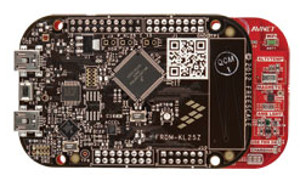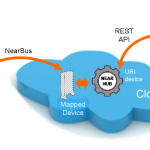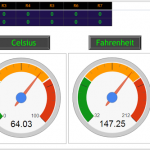The new Wi-Go system from Avnet is a complete development, prototyping and experimentation platform aimed primarily at wireless data acquisition, wireless sensor networks, automation and Internet-of-Things applications – based on the Freescale Freedom Development Platform for Freescale Kinetis microcontrollers.
Avnet Wi-Go offers designers a complete solution for developing real-world IoT applications by combining Freescale’s Xtrinsic sensor technology with a powerful Kinetis-L microcontroller and an embedded Wi-Fi module.
The Wi-Go system adds Wi-Fi capability to the Freedom platform and includes a built-in 800 mAh lithium-polymer battery which can provide up to days of power for portable, wireless data acquisition from the platform’s on-board suite of sensors, along with an on-board flash memory IC to facilitate data storage and provide additional storage for things such as complex webpages which may be served up from the Wi-Go board, providing a powerful and flexible wireless sensor platform at a low cost.
To keep initial cost low, the Avnet Wi-Go is a two-board set comprised of a Freescale Freedom development board mated to an Avnet Wi-Go module. No other components arerequired to get started developing your own Internet-of-Things products and devices. The Freescale Freedom development platform is a small, low-power, cost-effective evaluation and development environmenbt aimed at quick prototyping and demonstration of applications of the Kinetis microcontroller family.
The Kinetis family offers an easy-to-use mass-storage device mode flash programmer, a virtual serial port and classic programming and run-control capabilities. The Wi-Go wireless accessory module extends this platform with a powerful suite of sensors, integrated battery and USB charging system, and wireless networking to meet an increasing demand for wireless sensor systems, portable data acquisition and connected, battery-powered Internet-of-Things applications.
The Wi-Go platform’s flexible sensor suite includes Freescale’s MMA8451Q accelerometer for 3D acceleration sensing, the MAG3110 low-power digital 3D magnetometer sensor for magnetic heading sensing, the Xtrinsic MPL3115A2 barometric pressure sensor, which provides pressure, altitude and temperature information, Vishay’s TEMT6200 ambient light sensor for light level sensing, a MAX8856 and MAX8625A for the power supply subsystem, including battery monitoring and smart charging, power management and efficient buck-boost regulation to maximise the system’s battery life.
These sensors are combined with the Kinetis KL25Z128VLK4-Cortex-M0+ microcontroller, operating at up to 48 MHz with 128 kb of flash and 16 kb of SRAM along with a full-speed USB controller and support for the sophisticated and open-standard OpenSDA USB serial and debugging interface, alongside Murata’s LBWAIZZVK7 Wi-Fi radio module, which is based on the Texas Instruments CC3000 SimpleLink 802.11b/g chipset.

As the WiFi communication hardware of the Avnet Wi-Go system are based on the CC3000 chipset, it supports TI’s SmartConfig network configuration tool, allowing easy configuration and provisioning of the wireless network settings for new Wi-Go devices on the network simply by using the SmartConfig app freely provided by TI on a smartphone connected to the wireless LAN.
The Wi-Go platform is also equipped with a S25FL216K low-power, 2 megabyte serial flash memory, flexible power supply options, a capacitive touch “slider”, an RGB LED and three discrete user LEDs as input and output devices for user interaction. The Wi-Go board also provides expansion I/O pins in a form factor that accepts Arduino-compatible “shields”, making it compatible with a rich ecosystem of third-party expansion hardware.
Example code is provided to set up a filesystem on the flash memory or to communicate with the flash in binary mode, along with other working code examples and libraries for communication with each of the other sensors, peripheral devices and WiFi radio present on the board.
Reference code and examples are provided to implement full end-to-end Internet-of-Things applications with Web services such as Exosite – for example using the TI SmartConfig app to configure wireless network connectivity, using cloud services client connection code to send data up to Exosite on the web, and streaming this data over the Web to an Android application which performs fusion of different sensor data and displays its results. It’s easy to get started logging sensor measurements on a Web service, for example, or to use a Web service to remotely select the colour of the RGB LED on the Wi-Go board.
A free cloud-based compiler is provided with each development board purchased, along with a free Freescale Xtrinsic sensor fusion toolbox application and a free connection to Avnet’s Exosite cloud services for up to two of your devices. A series of several videos is also offered by Avnet, outlining the capabilities of the Wi-Go platform in order to assist designers in creating Wi-Go based wireless applications.
These videos cover topics such as Xtrinsic sensor fusion on the Wi-Go platform, cloud capabilities of Wi-Go, and Web server and network configuration for Wi-Go. Finally, the Wi-Go platform is open-source, and designers have access to all design files and source code, which is an attractive feature for engineers looking to reduce the time to market for products and systems developed for Internet-of-Things applications.
And that is always one of the main goals of IoT product development – time to market. If you have a great prototype or idea – and need to take it to the market, our team of engineers can help you in all steps of product design, from the idea to the finished product. To get started, join us for an obligation-free and confidential discussion about your ideas and how we can help bring them to life – click here to contact us, or telephone 1800 810 124.
LX is an award-winning electronics design company based in Sydney, Australia. LX services include full turnkey design, electronics, hardware, software and firmware design. LX specialises in embedded systems and wireless technologies design.
Published by LX Pty Ltd for itself and the LX Group of companies, including LX Design House, LX Solutions and LX Consulting, LX Innovations.


